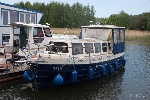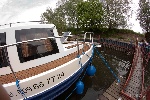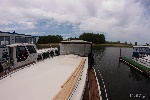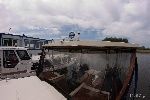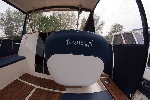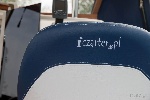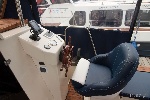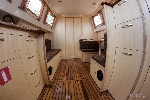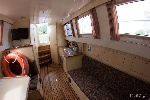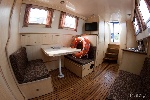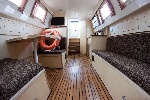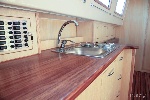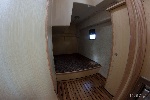User Manual yacht Vistula Cruiser 30
User Manual yacht Vistula Cruiser 30
1. Purpose Yacht
1.1. Rented boats are designed exclusively for tourism and water tourism on the trails Loop Żuławska and Elblag Canal with the exception of waters included in the Specific Conditions of the Charter Agreement.
1.2. Shipping is allowed only during the day.
1.3. She may lead a person trained his service.
1.4. The helmsman can not lead a boat under the influence of alcohol or other drugs.
1.5. For safety reasons, the crew should be used when swimming, life jackets, that are equipped yacht.
2. Receipt yacht
2.1. Upon receipt of the yacht must have the Rental Agreement, proof of payment, proof of identity. Receiving the yacht and its equipment shall be based on the Protocol Release and Return Yacht. Please double-check that the equipment listed in the protocol is a yacht and whether it is technically efficient. On our website you will receive expert advice on the use of the devices on the yacht. A large part of the knowledge of the rules of use of the yacht has been included in this Manual Yacht.
2.2. Besides, before you enter on the boat falls you know that the yacht must not:
2.2.1. Enter in shoes with hard, which leaves destruction soles (eg shoes on so-called. Pin)
2.2.2. On the yacht are non-smoking and the use of other open flames (candles, gas lighting, grill) - does not apply to built a yacht gas stove,
2.2.3. Do not let the fact that the compartments in the outer boat was water. Particular attention should be paid to the cleaning of the yacht when it is pouring too much water, which overflows the drains and inundates lockers,
2.2.4. Do not dry clothes, underwear, etc. By putting up her around the engine.
2.3. During the stop the boat always care about his duly mooring and protection against damage. To do this, absolutely not use reflectors that are equipped yacht,
3. Motor-handling
3.1. When swimming you should periodically check the operation of the coolant (water circulation).
3.2. Before starting the engine check whether the twist grip throttle / gear is in the neutral position,
3.3. Before starting the engine, check the fuel level in the tank, in the case of a small amount of refill with fuel (15%). Especially when swimming on the Vistula should take care to not run out of fuel. Average fuel consumption is approx. 3l / 1h, within an hour overcome distance approx. 6 km. Swimming upstream on the Vistula fuel consumption increases, the time is longer twice.
3.4. Before starting the engine, check that are enabled on the dashboard (position "1") supply the "Wheelhouse". We check to see if it works thruster, horn, wiper, echosodna, in case of poor visibility navigation lights turn on.
3.5. The engine starts by turning the key in the ignition,
3.6. Turn the key until you feel some resistance and wait a few seconds until it becomes hot and glow plugs,
3.7. Turn the key and start the starter. As soon as the engine starts - let go of the key,
3.8. During operation of the engine check the water outlet. No water outlet means no cooling. In this case, you should try to restore patency outlet / water intake:
3.8.1. Idling increase turnover - if the wires are slightly clogged increase in turnover should flush the cooling system. If this does not work use the following points 3.8.2, 3.8.3
3.8.2. We raise the motor up and check to see if it is clogged water intake (the grille plastic at the height of the screws).
3.8.3. Wire which is equipped box Bosmanski trying patency water outlet in the vicinity of the engine cover (top motor), including the press wire in the drain. If you turn on the engine is a stream of water, repeat the procedure from the point. 3.8.1
3.8.4. If still no water flow at the outlet of the compressor can borrow from the bosun on the harbor and blow compressed air cooling system - in order to affix the gun from the compressor to the outlets and run the compressor (without fear of damage to the engine).
3.8.5. If the point. 3.8.1 - 3.8.4 should fail to notify the owner of the unit of the problem with the cooling system. Swimming on engine without water circulation is prohibited.
3.9. Lighting up the red light and the appearance of an audible signal when the ignition is engine failures. In such cases, there is an absolute prohibition on re-starting the engine and the need to immediately notify the owner,
3.10. Turn off the engine by turning the key in the ignition, emergency pulling hauling. The most common problems with starting the engine: no skidding, lack of fuel, gear shifter, clogged fuel filter, air to fuel line.
3.11 Engine raise with button (up / down) located on the lever shifters.
3.12. When lifting care should be taken not to raise the engine too high and not damage the engine cover.
3.13. When swimming, pay attention not to accidentally lift the engine out of the water, slightly raised the engine will cause the deterioration of the possibility of maneuvering unit, too high up the engine will not have refrigeration, with prolonged action off the water line can lead to overheating.
4. maneuvers on the engine
4.1. Forward and backward throw by moving the handle forward or backward. Never directly switch the shift lever from the position, eg. '' Creep forward '' to '' reverse flow ''. Always before this maneuver, reduce engine speed to a minimum, put idle '' to play '' and then, after a pause, put another gear to forward or backward,
4.2. During the maneuver, especially in the ports we try not to use a large "amounts of gas." Due to the large inertia proper speed boats they reach only a moment. Using excessive "amounts of gas" by the impatient sailors often fatal, because the speeding yacht with a large mass can not stay in place,
4.3. The engine is liquid-cooled (water) should pay attention to the following proper circulation of the cooling agent (water) through the motor. If it does not turn off the engine and contact with the Lessor.
4.4. You should check periodically bolt the engine, if he is wrapped with plants or other "things" that hinder job.
5. Thruster
5.1. Activate / Activate thruster usually achieved by pressing the "lower" button (located on the control panel thruster) until the diode on the button.
5.2. Prepared to work thruster signals lit LED on the lower button.
5.3. Switching thruster followed by pressing and holding prawgo / left button, depending on which way we want to point the nose eg .: pressing the right, bow unit will head to the right.
5.4. Thruster should be used in pulses, ie. Should not work for more than 3 seconds of continuous operation, no more no such repetitions 4-5. We use a few seconds interval between each cycle.
5.5. Thruster is not a toy, not used for a course correction while swimming on the route, or rotate the boat 360 degrees (so-called. Tops). We use it in the maneuvers during the approach to the bridges and sluice chambers.
5.6. Failure to follow these instructions may lead to overload the motor and at best to fuse.
5.7. After a period of inactivity, thruster automatically goes to sleep, indicating the status of the flashing LED on the lower button (used to activate thruster). Again, the launch of the procedure must be repeated from the point. 5.1.
5.8. Using thruster should pay special attention to in its vicinity there was no seaweed or other objects enable blocking rotor thrust, which can cause permanent damage to the transmission thruster. Pay special attention to the mooring lines bow during maneuvers in port or in locks that have not fallen into the water while the rudder. Lina bow in the water is the most frequent cause of damage to the thruster!
6. mucous yacht
6.1. Preparation for śluzowania
6.1.1. Before the process śluzowania yacht, call the service lock, report them to the intended sluices. You will get information about the conditions of return and you will have opened the sluice gates, so you will not have to moor directly to the dolphins just before the lock. We recommend that you contact the service lock at least 30 minutes before arriving at the lock. Phonebook for operating the lock located on each yacht. Try to prepare deducted coins for lockage.
6.1.2. Before starting the process śluzowania we need to check reflectors - check if they are all on wsłąściwym place and properly will protect the side of the unit against abrasions.
6.1.3. Before starting the process śluzowania must prepare crampon and mooring lines: bow and stern. Make sure that the mooring lines are not tangled, tip cum either wear cleats yacht, one cleat on the bow, the other at the stern cleat.
6.1.4. Upon receipt of the lock, moorings assume to "crosses" located in the holes of the walls of the lock. Warning !!! Two ends of the mooring lines as when the crosses did not attach to the boat! Only one end of each of cum is attached to cleats, hawser should only be translated into the spider, the second of its tip should be kept in the hands of a crew member. Ratio and affection of all terminals cum during śluzowania, in particular pumping water from the lock can lead to damage to the yacht (cleats will be uprooted).
6.1.5. During the influence and leaving the airlock must protect two sides of the yacht, paying particular attention to the right side - not to hit the right sluice gates, which are generally not open.
6.2. Lockage yacht - during śluzowania should hear directly commands service staff lock, if in any doubt, please ask them or ask for help. To sluice for avid motor must protect the side of the boat, you need to consider that you may experience a stronger current of water in front of the gates of the lock, or a gust of wind.
6.3. During the śluzowania should pay attention to the limbs of the crew were not between the walls of the lock and burtom boat, rocking boat during śluzowania can easily break the hands and legs of crew members.
6.4. It was only after adjusting water levels in the mucus relative to the river / canal and open the lock gates, we can prepare to exit the airlock, this time the yacht absolutely must be anchored to the walls of the lock. After receiving the information from the employee operating the lock we prepare to leave the airlock. First, turn on the engine, then let go and roll up mooring lines fore and aft, we give a little gas to fronts or backward to decelerate in accordance with the principles of operation of the engine.
6.5. During the influence and flow out of the airlock must be careful, you must protect the side of the yacht.
6.6. During the entire process śluzowania safety reasons, the crew should not leave it, in particular to climb ślizgich, metal steps ladder mounted on the wall of the lock
7. Interior and Galley
7.1. Caboose:
7.1.1. To light the gas stove should be:
7.1.1.1.1. unscrew the gas cylinder valve to the left,
7.1.1.1.2. turn on the oven, press it and set fire to gas,
7.1.1.1.3. after ignition of the gas tap hold down for a few seconds, in the opposite case the flame goes out,
7.1.1.1.4. Extinguishing the flame after turning off the tap in the oven,
7.1.1.1.5. If you need to replace the gas cylinder Please note that the threads on the reducer gas is '' left-handed ''
7.1.1.1.6. The main valve should be opened only for the duration of the oven, otherwise safety reasons should be closed.
7.1.2. Note: under no circumstances can disassemble the oven burner or gas regulator.
7.1.3. It happens that when cooking something spilled and the oven is flooded together with the interior of the burner. You should not on its own disassemble the burners. Allow the plates to dry naturally, or failure to report to the shipowner.
7.1.4. Before using the water pump switch button located on the board. After using the water pump must be switched off immediately.
7.1.5. Do not turn on the electric water pump with empty tanks for water. Pump operation '' dry '' may cause permanent damage to the pump.
7.2. interior:
7.2.1. Do not remove the mattress from inside the yacht in order to position them, eg. On the grass, the fire on the wet deck, etc., And use as a place to sit,
7.2.2. Do not place Kapok in the compartments outside the yacht and not use them for fun, convenience, eg. Bathing in the river as a campfire,
7.2.3. Plastic galley equipment should be kept away from the activated gas stove,
7.2.4. Do not cut into any wooden parts of the yacht - use the cutting board, which is supplied with each boat. Varnished wood is not the same as kitchen countertops. Slicing bread on a wooden boat or other item can be compared to cutting bread on the hood of the car - the effect is similar,
7.2.5. Galley equipment (especially pots, plates, cups and others) must be dried after washing out of the yacht or wipe and then put in the cabinets inside the yacht,
7.2.6. Spreading berths caution and in no case do not use excessive force. If makeweight berth does not come, it means that we put it upside down or in place of improper use,
7.2.7. To clean the water tank Do not pour water from lakes, rivers - contamination can damage the water pump,
7.2.8. During the voyage the interior of the yacht should be regularly aired, and the rainy, humid weather it is advisable to occasionally put mattresses on end, that moisture is under the mattresses had the opportunity to evaporation.
7.3. television
7.3.1. Before starting the TV switch on the fuses on the dashboard to 1.
7.3.2. When finished using the TV, switch fuses on the dashboard to "0".
7.3.3. We turn on the TV using the remote control.
7.3.4. TV is powered by a 12v socket, do not connect the socket 230v.
7.3.5. Memory sticks plugs directly into a USB port.
7.3.6. The TV is mounted on a wall bracket.
7.3.7. Warning! Under no circumstances should you turn the TV grabbing directly behind him. Should be marketed directly by holding the tip of the wall bracket. Breaking VESA brackets on the TV will be treated as the destruction of the whole TV.
7.3.8. Place the TV on the wall, forbidden to move and detach the TV.
7.4. Flip-down table in the mess.
7.4.1. The table in the wardroom to dialed is mounted on a metal alloy.
7.4.2. Before leaving the table, first unscrew the "metal butterflies", bolted to the two screws at the edge of the table, which affects the inner wall of the yacht, then unscrew the gray socket with thread at the bottom of the white table leg.
7.4.3. After unscrewing and butterflies, threaded sockets, you can gently lift the table up.
7.4.4. At dismantling the table, unscrew the white leg, then the same plate tables mounted in place of a fold-out seat or placed in locker
7.4.5. During the unfolding of the table must first leg of the table fit in the slot, tighten the connector with thread, at the end of screwed metal butterflies.
7.5. Cockpit table.
7.5.1. Equipped boat is a folding table in the cockpit. We mount the plate of the table leg.
7.5.2. Stola with mounted and tightened leg mounted in the slot on the floor of the cockpit.
7.5.3. After installation tighten gray threaded socket.
7.5.4. Cockpit table may slightly "rocking", so be careful when eating hot food on it.
7.6. Gas heating;
7.6.1. Equipped yacht is a detailed manual heating Eng supplied by the manufacturer of heating. Before turning on the machine, read the instruction manual and follow the. instructions contained therein.
7.6.2. When the gas stove and the heating unit are mounted gas detectors. In the event of a burglary alarm should turn off the gas cylinder, open the windows to ventilate the purpose of the room. You should report this to the shipowner.
8. Toilet and Shower
8.1. Using the toilet electricity.
8.1.1. Before using the toilet should be checked on the dashboard or electric toilet is attached.
8.1.2. Water for flushing toilets electricity comes from the water tank, before using, check that the water is in the tank. Using the toilet without water can damage the engine from the toilet.
8.1.3. After using the toilet, press the button on the wall behind the toilet.
8.1.4. If we have to use more toilet paper's do the operation flush twice, too much paper can clog the toilet itself.
8.2. Using the shower.
8.2.1. Before using the shower should leave the sink.
8.2.2. We do not use large amounts of water to water tray is not overflowed.
8.3. Under no circumstances throw sanitary towels or other things into the toilet toilet, for this purpose the trash, use of toilet paper in moderation. Inserted large amount of paper / napkin can clog the toilet, the toilet is allowed to push the process time-consuming and difficult to implement. In the case of clogged toilets electricity from misuse, you will be billed for the repair toilets and losses resulting from downtime yacht during repair.
9. tank dirty water (faeces).
9.1. Holding tank has a capacity of 50L. Tank level faeces is displayed on the dashboard.
9.2. If the three-way valve is set to drain the tank for faeces, before each using the toilet or shower, check the fill level of the tank.
9.3. Too frequent use of the toilet and the shower can cause fill up the recovery tank! You should always control the level of full water fecal matter! After reaching tank faecal 80% using the shower is allowed after reaching the level tank for faeces 90% of the use of toilets is prohibited.
9.4. The hole for pumping sewage from the tank is located on the starboard side, at the height of the right pane of the fore cabin.
10. Tank for drinking water.
10.1. Drinking water tank has a capacity of 200L. The filling level of the water tank is displayed on the dashboard.
10.2. The infusion of clean water is located near the forepeak, in the bow of the yacht. Pay special attention not to pour water into the fecal matter!
10.3. In order not to overload the boat does not pour drinking water more than 80% of the fill level. Overload unit will tilt the bow down and increase fuel consumption.
11. The tank of petrol.
11.1. The fuel tank has a capacity of 100L, the current tank level is displayed on the instrument panel of the unit. Before each voyage, check the fill level of the fuel tank. It is forbidden to leave the port with the fuel level below 10%.
11.2. Fuel tank is located on the floor of the left side of the stern. Nut is marked with the inscription "Fuel". Warning ! The motor is powered by unleaded fuel (95 PB). It is strictly forbidden to pour another type of fuel and water. This may cause permanent damage to the engine!
12. Anchor and mooring lines
12.1. The use of bow anchor:
12.1.1. Anchor Bow (Type pługowego) is laid on the rollers located on the gangway bow, the rope is attached to knadzę, excess cable is tucked away in the forepeak.
12.1.2. Before leaving the port check if the rope with bow anchor is not tangled.
12.1.3. Anchor leave by odwiązaniu knots with cleats fore, under the influence of gravity after releasing the anchor itself falls into the water.
12.1.4. It is forbidden to leave for fun and raise anchoring, especially when moving the unit.
12.2. Not used stern anchor hiding only to the forepeak (in the bow of the yacht). Do not place the anchors in the compartments other, because they can permanently damage found in these facilities.
12.3. Mooring the yacht during the voyage should be clarified and secured in such a way not to lose them during the voyage.
12.4. Standing on the anchor should pay particular attention to where the anchor thrown - this should be done in such a way as not to constitute a danger to other users of the waterway.
13. Damage to the yacht
13.1. In case of serious defects, failures or other damage during the term of the charter agreement, the tenant is obliged to immediately notify the landlord and the preparation of "emergency protocol" ( "Protocol accident"), which is the basis for the landlord to apply for compensation to the insurance company. After consultation with the shipowner will be established Remedy fault
13.2. Always we help and provide service on the route.
13.3. Never attempt to make your own decisions, eg. On how to repair hull yacht or other serious damage.
13.4. Without the consent of the landlord tenant can not make changes to the equipment and construction of the yacht,
13.5. In case of loss or damage to the equipment of the yacht, you can supplement it on your own, but remember that it must be of the same genus, species, size, color, brand and quality, so that the equipment of the yacht was uniformly good quality. For example. You can not replace a lost fender small large.
14. Taking care of the environment, using the toilet and sink.
14.1. Regardless of the type of toilet that has been installed on the yacht, the Charterer agrees to use the toilet in accordance with applicable regulations, and in particular in accordance with environmental regulations and take full responsibility in this respect,
14.2. To the toilet, do not dispose of any securities (even soluble) and other means of personal hygiene,
14.3. Boat washing detergents should use sparingly. The best solution is the use of special funds allocated for such applications that have minimal impact on the environment,
14.4. Do not pollute rivers by throwing them cans, bottles, cigarette butts, and many other things. For example, a cigarette butt thrown into the river / lake pollution causes about one cubic meter of water. Before sailing on a cruise, do not forget to stock up on garbage bags,
14.5. Pay particular attention when topping up the fuel so as not to spill it into the water,
14.6. Drains from sinks and sinks located on the yacht have their outlet overboard a yacht. Therefore, for the protection of the environment is not recommended for dishwashing using a sink mounted on the yacht. Better, faster and more efficiently will be when we use a specially designated for this purpose places in the ports.
15. Before opinion yacht
15.1. Due to the fact that cleaning the yacht after the cruise is not a pleasant activities and not everyone has to feel like it, you can order cleaning of the yacht (price list). Otherwise, the boat should be prepared to pass in a suitable manner:
15.1.1. Check carefully if we took all of their belongings from the yacht,
15.1.2. Mattresses should be placed upright and open all the hatches boat (if weather permits)
15.1.3. We clean boat with particular emphasis swallows, lockers, bunks and wash off the floor. When washing, we try not to use excessive amounts of water. Brush, shovel and damp cloth will suffice to get rid of sand and other impurities from the bunk, lockers or other corners of the yacht,
15.1.4. Wash the exterior lockers and choose from them the water and wash the deck,
15.1.5. Wash galley equipment (pots, plates, glasses, cutlery, etc.) And leave them on the outside of the boat so that they can dry out (if weather permits)
15.1.6. Wet moorings hang out to dry (if weather permits)
15.2. The average time that staff spend on the clarification of the yacht is about 2-3 hours. This time should be taken into account when planning the time at which the boat should be returned to the shipowner. When a boat is clarified, please prepare the documents - the charter contract and the handover protocol and notified the owner.
16. Closing remarks
16.1. This guide was written for applied technical solutions, equipment and patents listed on yachts of iczarter.pl and based on years of observation and personal experience. This guide should not be regarded as only right and good source of knowledge. Sailing in many situations should be guided by sailing experience, logic and common sense.

